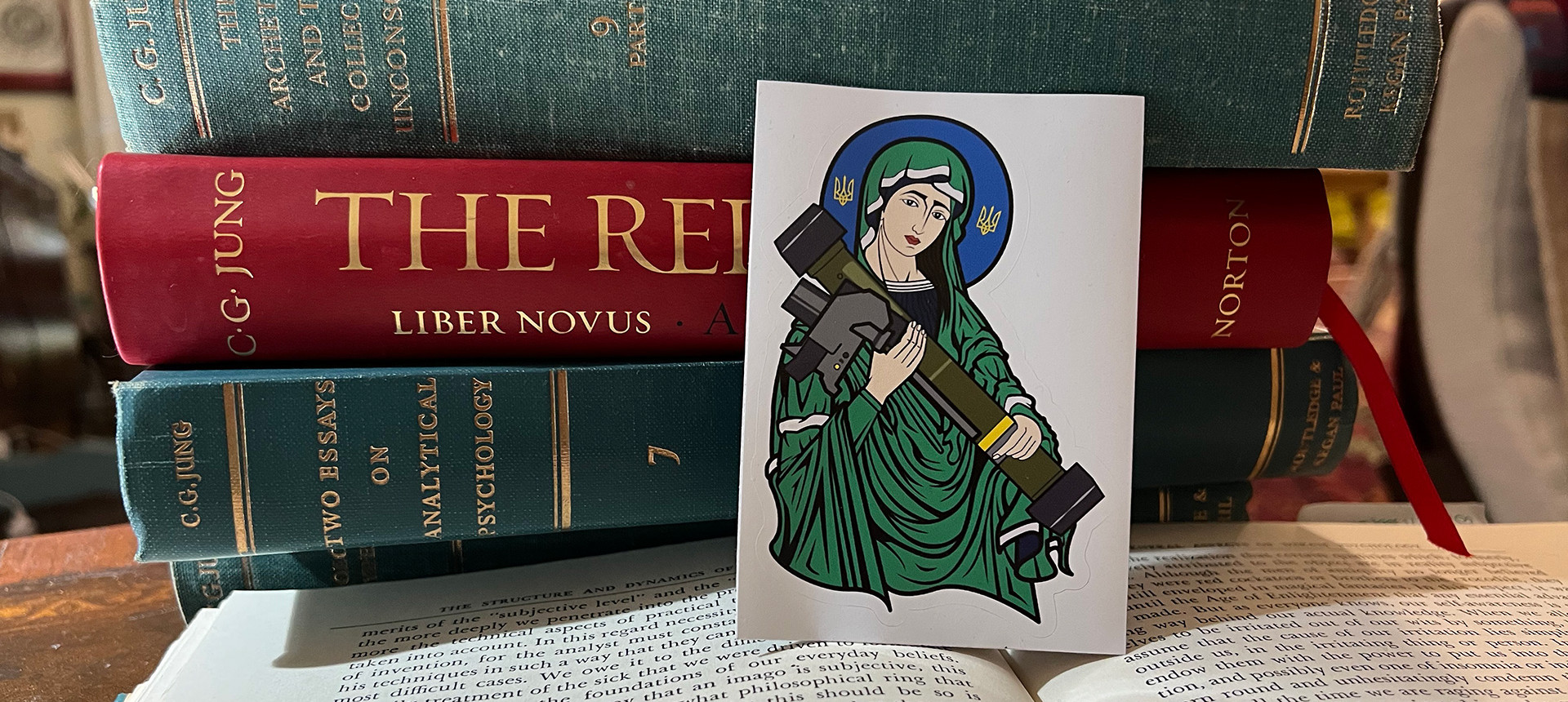
Saint Javelin: The Rebirth of a Symbol
Globalization has never been a more poignant notion than it has during these past three years amidst the Covid-19 pandemic. The on-going war in Ukraine and the potentiality of a Third World War is a fitting caption to this worldwide state of awareness: If and when it happens, it shall involve the whole world. And so, the world is watching; watching devastation and desolation.
While scrolling to find something that would give me some sense of clarity, a news sites opens unexpectedly on my screen (‘pop-ups’: what a concept! Just like a thought. unwanted, unexpected, and all too captivating). I see an image that makes me pause. The caption: “Saint Javelin”. It’s a familiar image, yet, wholly unfamiliar as a female Orthodox saint holding a modern weapon. Besides the massive weapon in her hands, the halo would make anyone familiar with Orthodox Christian iconography stay with the image: Instead of the usual golden light, she’s illuminated by the colors of the Ukrainian flag. Evidently, the source of the saint’s holiness has been tampered with. The choice of her attire is equally striking since she is not painted in the typical Byzantine colors. Saint Javelin is dressed in military khaki. And, as if the divergence from what had been stored in my collective knowledge as ‘proper iconographic presentation’ had not been enough, the saint appears to be wearing lipstick. Wait, is she even a saint?
Turns out there’s no saint named Javelin. You are allowed to laugh at me, you war-savvy people out there. I’m actually proud I didn’t know what a Javelin is until today. The Javelin (for those ignorant few) is an American-made missile launcher, an anti-tank weapon, which is being supplied by NATO countries to Ukraine during these past weeks.
This image is the creation of a Canadian artist Christian Borys, who worked in Ukraine as a journalist in the past. Saint Javelin became a meme of resistance to Russian occupation via stickers he created to fundraise for Ukrainian children. Borys was surprised with its appeal which raised it from a mere sticker to a meme, literally overnight. The artist was unconscious about the strength of the symbol he created, and perhaps unconscious of the fact that he was creating a symbol at all.
Saint Javelin is more than a mere meme. This image is a fresh symbol of resistance, even though the idea is not new: countless wars were fought with the blessings of god(s) and saints. The armies of the Christian world have patron saints adorning their weapons, tanks, flags, and camps.
There is incredible power in symbols, and their force is mostly unconscious. We are not aware of their potency and we react to them spontaneously. Think of the cross, a symbol that is still alive (symbols can ‘die’, that is, they can lose their appeal unto our unconscious): A practicing Christian responds unconsciously to a cross with reverence and devout respect.
Saint Javelin was based on an image of Mary Magdalen, one of the most controversial and esoteric figures of Orthodox Christianity. The stories vary: The student who Jesus had closest to him; the sinner who was given a second chance by Christ; the woman whose gospel was excluded from the Bible. I suppose this is quite a fitting choice: The underdog, who is given the chance to shine, finally included in the holy team.
But a modern weapon? Mary Magdalen holding an anti-tank weapon … Whatever happened to her? War happened. Jung would call an Orthodox Christian icon a ‘cultural symbol’, as opposed to a ‘natural symbol’, and as such it is meant to express ‘eternal truths’. There’s no more universal truth than war. Humanity wages wars: humans kill humans, this is what we do. Humans, aggressively and forcefully attack other humans. There are the perpetrators and the victims, though it’s not always clear who is who. There are the Davids and the Goliaths.
Religious symbols have a particular function. Their role, Jung explained in ‘Man and His Symbols’ is to give meaning to the life of humans. A symbol is a powerful representation, an image that moves the psyche, in most cases collectively, in mysterious ways. As Jung put it, “The symbol becomes my lord and unfailing commander.”1 And when a symbol no longer gives effective meaning, it has to be reimagined or, to use Jung’s words, it has to be dreamed onwards.
Saint Javelin is a much more potent symbol than a saint in her usual state of being: placid, peaceful, tolerant. At this point in history a new symbol is needed, and so it is brought forth.
A symbol has “the great advantage of being able to unite heterogeneous or even incommensurable factors in a single image”2 . In the image of Saint Javelin the holly is united with the polemical. It is a recreation of the Christian mythology, a revisioning of sorts: ‘thoughts and prayers’ alone won't do; there need to be arms.
In a prophetic way, Jung spoke of the need for metamorphosis of the gods by humanity in order to avoid annihilation by our own creations, namely technology and science3. Perhaps, if we are lucky enough to avoid annihilation this time around, we will be able to re-vision once again this symbol. We might return to the unimaginative and jaded symbol of the dove of peace to replace the Javelin. Or perhaps we could (re)turn to Jung’s words: “Life is a battleground. It always has been, and always will be; and if it were not so, existence would come to an end.”4
[1] C.G. Jung (2012) The Red Book: Reader’s Edition, Philemon.
[2] C.G. Jung (1938/1954) The Archetypes and the Collective Unconscious, CW9i
[3] C.G. Jung (1958) The Undiscovered Self
[4] C.G. Jung (1964) Man and His Symbols